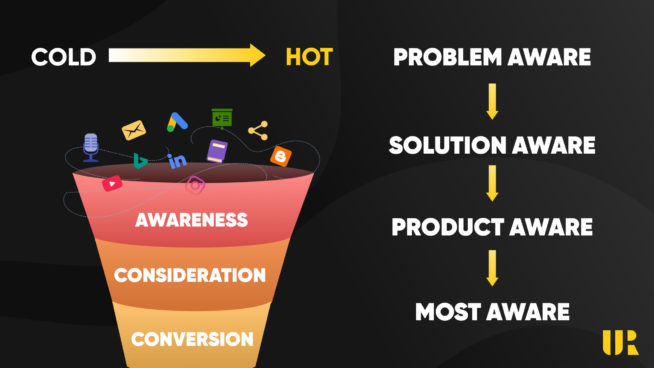This is a guest post by Todd Chambers. Todd has spent nearly a decade of his life managing paid media spend. He is the founder & director of Upraw Media where he and his team help SaaS companies accelerate growth through PPC, analytics and conversion rate optimisation.
Getting your SaaS brand seen by the right people is important, which is why so many companies are turning to paid ads thanks to their powerful targeting options.
However, while there are plenty of SaaS businesses tapping into this technique, very few get it right. The biggest mistake brands make is using low-funnel, direct response ads on freezing cold audiences.
Structure
Translating the SaaS Sales Funnel into Paid Ads
Targeting Options for the Awareness Stage
Creative Ideas for the Awareness Stage
Targeting Options for the Consideration Stage
Creative Ideas for the Consideration Stage
Targeting Options for the Conversion Stage
Creative Ideas for the Conversion Stage
This might work for businesses that sell impulse-buy products (like socks), but the digital nature of SaaS products makes explaining them to people who aren’t tech-savvy incredibly difficult.
There are also different kinds of users, which we’ve outlined in the graphic below. You can run direct response ads to users that are “most aware” because they are already educated on their need for a product or solution. But users that are not aware they have a problem, let alone know that they need a solution, need educating. This means the amount of content you need to serve them increases.
Targeting users that aren’t problem aware can be expensive. And, if the cost is high, the risk is high, which is why more content is needed.
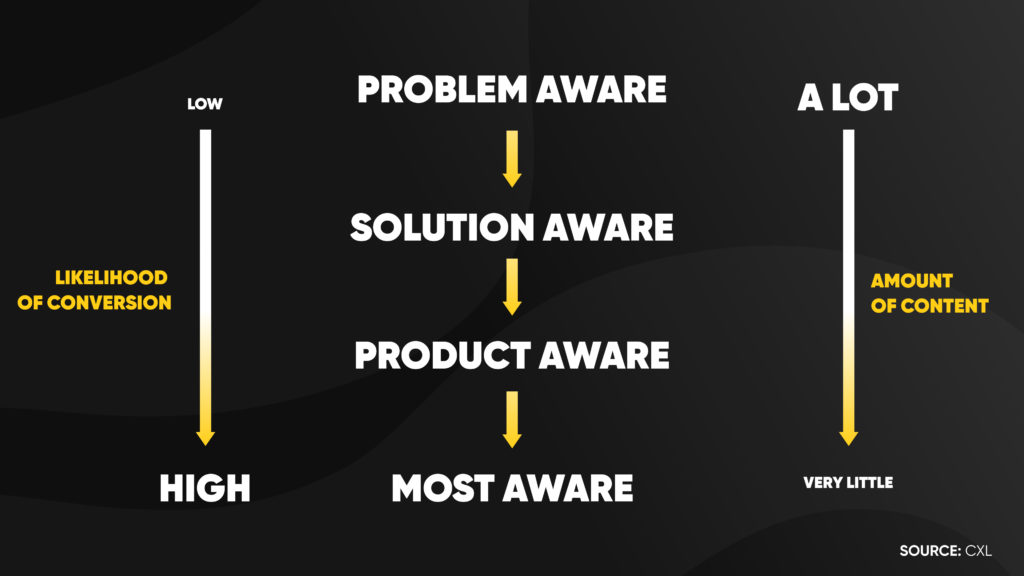
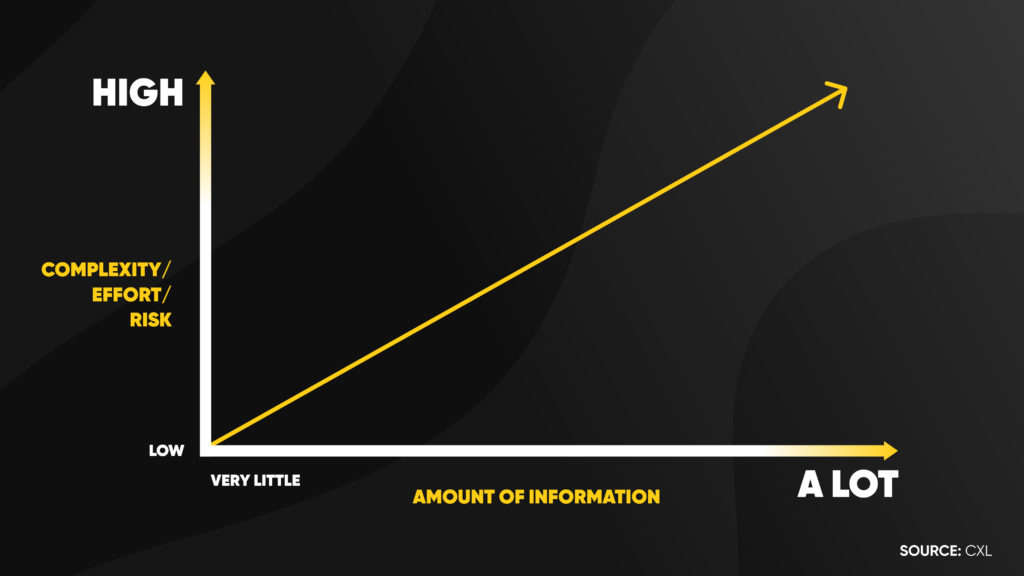
The Wrong Way to Do It…
For many SaaS brands, running paid ads in any way is better than nothing – even if it means capturing just a few loosely relevant leads. As a result, these brands are creating basic ad campaigns that target cold audiences and top of the funnel prospects only.
This is evident in the swathe of ads we see that use direct CTA focused ads encouraging people to “buy this right now!”.
What you have to bear in mind is that cold audiences don’t know you or your product and therefore take more convincing to part with their cash. According to research, it takes on average seven touchpoints with a brand before someone buys, which is evidence that it’s very unlikely that they’ll buy from a single ad the first time they see it.
We’ve also hit a time where social media users are more skeptical of ads than ever before. This means it’s absolutely vital to build trust and serve huge amounts of value before trying to sell anything.
The Right Way To Do It…
Before we dig into targeting and ad creatives, it’s important to understand the SaaS sales funnel, or the journey that SaaS buyers go on before they invest in a product.
There are three key stages to the SaaS sales cycle:
- The Awareness Stage (top of the funnel): this is when people don’t even realise they have a problem that needs solving or, at most, are just beginning to become aware that they have problem
- The Consideration Stage (middle of the funnel): this is when people understand that they have a problem and are looking for a solution by weighing up their options
- The Conversion Stage (bottom of the funnel): this is when people are right at the bottom of the funnel and are ready to invest in your product
To put it simply, people at the top of the funnel are cold prospects who need more convincing, and people at the bottom are warmer leads that are usually aware of your brand and your product. They need less convincing to invest.
The key to running successful paid social media ads is to align them with the different stages of the funnel. You can do this by offering value based on the needs of your leads in each stage, because people need different information at different stages of the funnel.
So what would this look like in action?
This means that, instead of creating a couple of direct CTA ads that target cold, top of the funnel leads, you create a more complex series of ads that funnel users from one stage to the next depending on their needs.
You can also change the campaign objective. Marketers tend to run ads just to website visitors. However, for best results, you want to try out two or three different campaign objectives for each stage of the funnel to see which ones get the best results.
If you think this sounds expensive, you’re not alone. However, the majority of your budget should be spent targeting cold audiences during the first step of the process. This cost should be spread across a selection of different campaign objectives using the minimum budget requirement for the platform (which is $1 per day on Facebook) to see what works best.
From there, you can do more of what’s working.
Translating the SaaS Sales Funnel into Paid Ads
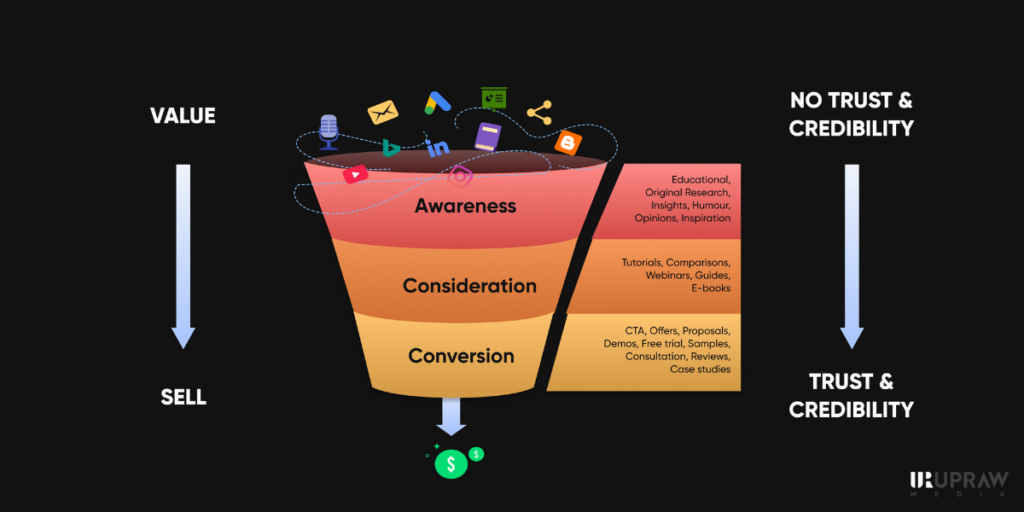
Step 1: Awareness
Prospects in the awareness stage of the funnel are just wising up to the fact that they have a problem that needs solving. Maybe they’re struggling to analyse data quickly and accurately. Maybe they’re manually updating their customer files. Maybe they’ve run out of space on their cloud storage system.
The ads you serve at this stage should focus on the problem your product solves.
But before you start thinking about what the ad will look like and what it will say, it’s important to get your targeting right. For the purpose of this piece, we’re focusing on Facebook and LinkedIn. Both of these platforms can reap fantastic results, but they are slightly different in their audiences and ad setup.
LinkedIn’s audience is predominantly other businesses, so many SaaS brands advertise here to reach a B2B audience. Facebook, on the other hand, is populated by general consumers and is therefore often a better space for B2C SaaS brands to advertise. However, there will always be some overlap, so it’s important to figure out where your audience spends the majority of their time.
Targeting Options for the Awareness Stage
Audience targeting for paid ads can be separated into two general categories: prospecting and remarketing. At this stage, your targeting will fall into the prospecting category, because you want to reach people who haven’t visited your website or signed up for your list yet.
There are several ways you can do this.
Create a Lookalike Audience
If you already have solid data about your customers, you can use this information to target similar people. For example, you can upload your email list or a list of website visitors tracked via a Pixel and generate a lookalike audience based on the demographics.
You need a minimum seed audience of 100 members to get started, but ideally you want a list of at least 2,000 past customers, subscribers, and website visitors to work with.
Target Your Persona Profiles
If you haven’t already created a set of persona profiles for your brand, now’s the time to do so (here’s a handy guide on how to do it). You can then use demographic and psychographic information to target people that closely resemble that profile.
For example, you might decide that one of your persona groups are marketing directors between 30 and 60 years old who live in a certain city.
LinkedIn ad targeting also lets you hone in on specific persona types, but with more work-based focus.
Take Inspiration From Your Competitors
Your competitors will have very similar persona profiles to you which you can use to your advantage. Facebook has the option to target people who follow the business page of another brand or who are involved in a specific Group.
This option can be powerful if you don’t have enough data to create a lookalike audience.
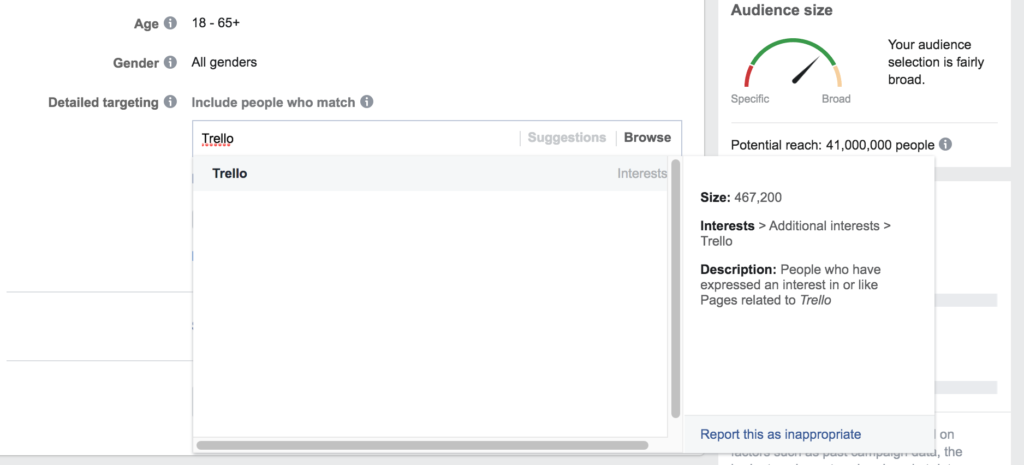
Creative Ideas for the Awareness Stage
Once you’ve figured out your targeting, it’s time to focus on the ad creatives. At this stage, the main focus should be introducing your solution to target users and providing content that’s consumable in-platform. You can include a link or a CTA, but this should be secondary.
The best creative formats for this stage of the funnel include:
- Videos that don’t show off your product, but actually tackle the pain point your target user has. The mistake people often make here is thinking that videos have to be shorter than 15 seconds, but in fact this isn’t always the case. It’s worth mixing things up and using both long and short videos. Short videos work better at more advanced stages of the funnel, like a fast-paced video that shows the key benefits of the product and a powerful CTA, for example. Longer videos work better on cold audiences. Even if a video is 5-10 minutes long, it can provide great insights into who watched how much of the video.
- Image ads that present an eye-catching solution to your target user pain point
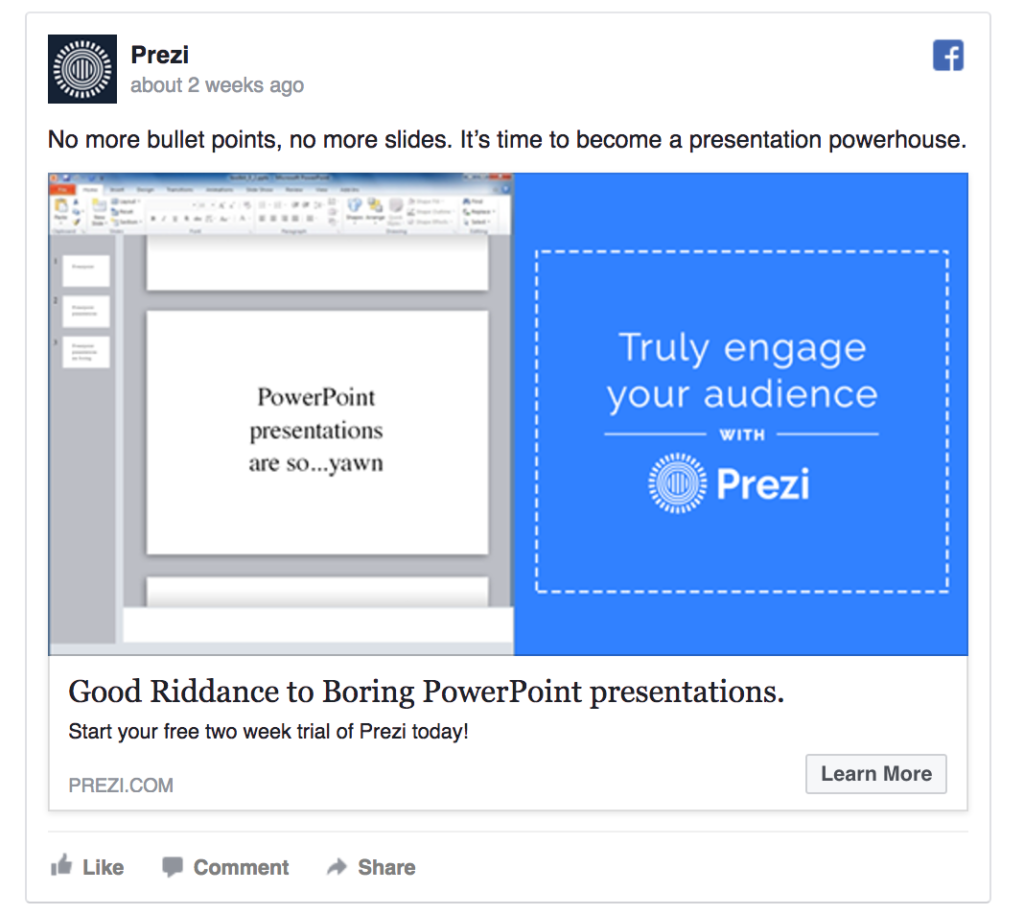
- Instant experience ads that combine images, videos, GIFs, and text under the surface of a mobile ad
Videos are often the best way to start a buyer’s journey with you because they allow you to introduce your brand in an engaging way.
Step 2: Consideration
Your ads that target people in the consideration stage of the funnel should aim to move them down to the conversion stage.
Targeting Options for the Consideration Stage
Engagement Targeting
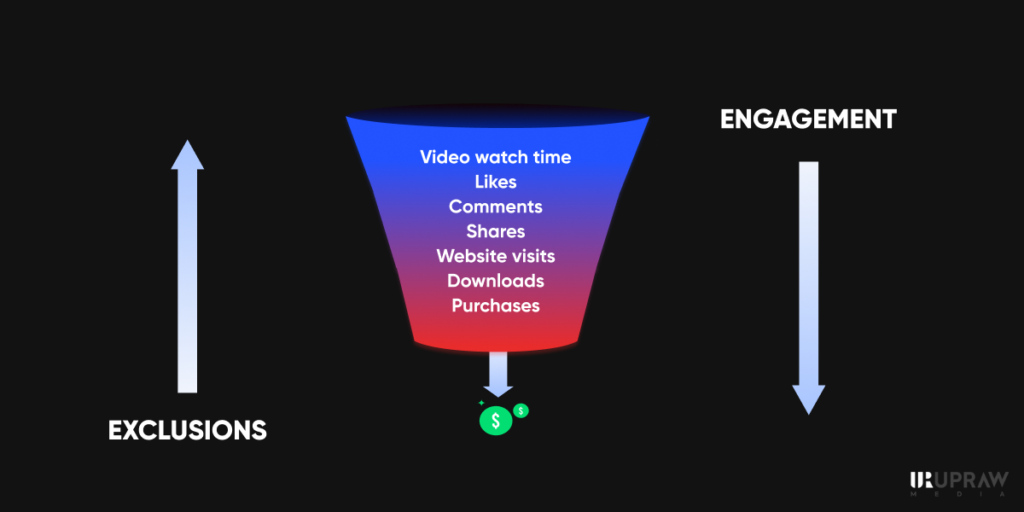
Facebook is more sophisticated than LinkedIn in that it allows you to reach people who have previously interacted with your content on Facebook.
For example, you can target people who watched your video in the awareness stage, people who have interacted on your Facebook page, or people who have engaged with an event you have posted on Facebook.
LinkedIn is slightly different in that you can only move people down the funnel based on visits to your site.
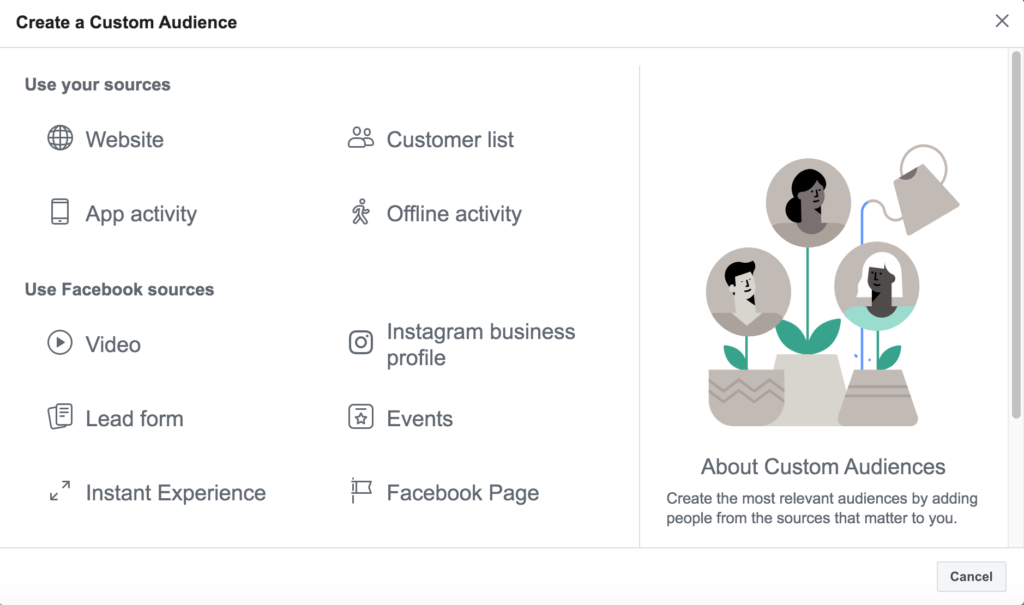
Remarketing
Alternatively, you can target people on your email list or a CSV upload of your past customers. Or, through remarketing techniques, you can track users who have visited certain pages of your website using a Pixel. For example, you might target people who have visited:
- Your homepage
- Specific product pages
- Your sign up or pricing page
Alternatively, you can connect your CRM to your ad accounts and generate audiences and lookalike audiences from that.
Creative Ideas for the Consideration Stage
At this point in the sales funnel, people know they have a problem that needs solving and they’re weighing up the different ways they can do that.
Ads to focus on at this point include:
- Another video ad that highlights the benefits of your product and positions it as the best solution for your target users
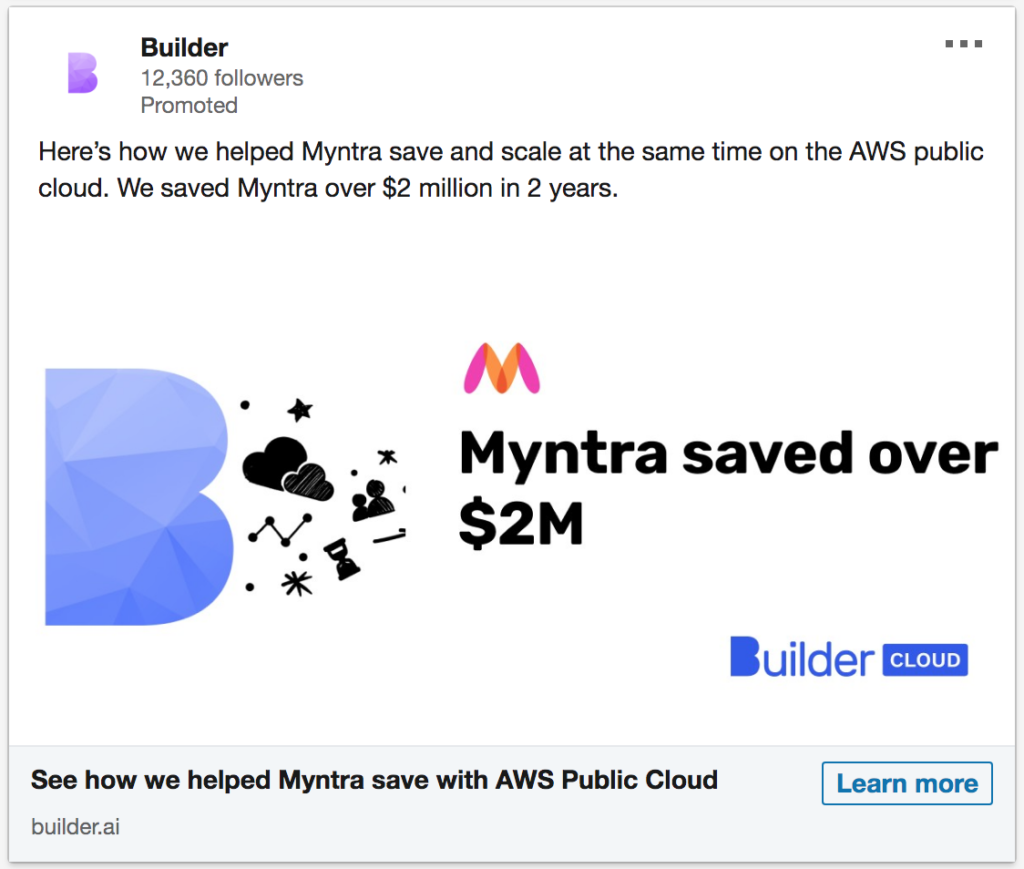
- Customer stories that show off how your product has helped other users succeed
- A comparison of your product with a well-known competitor
- A link to a download that presents your product as the best solution
Step 3: Conversion
At this point in the funnel, prospects pretty much have their wallet in their hand and are ready to buy. They just need that final push from you.
Targeting Options for the Conversion Stage
Warm leads should be your focus now. These are the people that have interacted with your brand in a number of ways and are well aware of who you are and what you offer.
Target Warm Leads
Through Facebook’s focused targeting options you can target users who have watched your consideration stage video, downloaded the guide you offered, or commented and interacted with your customer story or comparison post.
Ideally, you should be targeting people who also interacted with your consideration stage ads.

Creative Ideas for the Conversion Stage
The audience you’re marketing to now are pretty much as warm as possible and this is your chance to sell them your product.
There are two types of ads you want to run at this stage:
- Ads that send them to your product page, pricing page, or a dedicated landing page where they can sign up
- Ads that encourage them to book a demo or sign up for a free trial
We used this sequencing approach to create a successful funnel of paid LinkedIn ads for Builder.
We began by creating videos to attract top of the funnel users. Once these people had visited the Builder website, we then remarketed to them using consideration and conversion stage appropriate ads.

Make Paid Ads a Game Changer
Paid social media can be a game changer for SaaS brands – but only if they do it right. It all starts with a deep understanding of the sales funnel and creating content and valuable information that taps into the needs users have at each stage.
Our systematic (or sequencing) approach moves users down the funnel from the awareness stage to conversion, but it’s important to test audiences, campaign objectives, and creatives to ensure you’re getting the best results.
